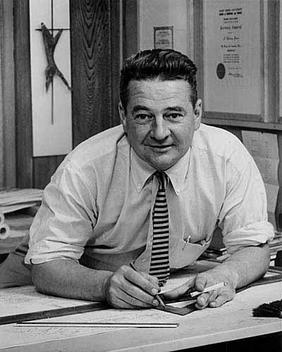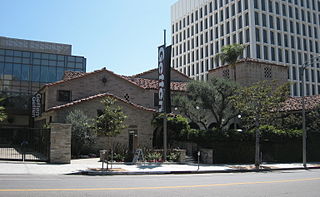
Ray Douglas Bradbury was an American author and screenwriter. One of the most celebrated 20th-century American writers, he worked in a variety of genres, including fantasy, science fiction, horror, mystery, and realistic fiction.

The University of California, Los Angeles (UCLA) is a public land-grant research university in Los Angeles, California, United States. Its academic roots were established in 1881 as a normal school then known as the southern branch of the California State Normal School. It was absorbed with the official founding of UCLA as the Southern Branch of the University of California in 1919, making it the second-oldest of the ten-campus University of California system after the University of California, Berkeley.

Westwood is a commercial and residential neighborhood in the northern central portion of the Westside region of Los Angeles, California. It is the home of the University of California, Los Angeles (UCLA). Bordering the campus on the south is Westwood Village, a major regional district for shopping, dining, movie theaters, and other entertainment.

Thom Mayne is an American architect. He is based in Los Angeles. In 1972, Mayne helped found the Southern California Institute of Architecture (SCI-Arc), where he is a trustee and the coordinator of the Design of Cities postgraduate program. Since then he has held teaching positions at SCI-Arc, the California State Polytechnic University, Pomona and the University of California, Los Angeles (UCLA). He is principal of Morphosis Architects, an architectural firm based in Culver City, California and New York City, New York. Mayne received the Pritzker Architecture Prize in March 2005.

The Los Angeles Public Library system (LAPL) is a public library system in Los Angeles, California. The system holds more than six million volumes, and with around 19 million residents in the Greater Los Angeles area, it serves the largest metropolitan population of any public library system in the United States. The system is overseen by a Board of Library Commissioners with five members appointed by the mayor of Los Angeles in staggered terms, and operates 72 library branches throughout the city. In 1997 a local historian described it as "one of the biggest and best-regarded library systems in the nation." It is not to be confused with the LA County Library system which operates several library branches across certain areas of Los Angeles County.
The UCLA School of Education and Information Studies is one of the academic and professional schools at the University of California, Los Angeles. Located in Los Angeles, California, the school combines two departments. Established in 1881, the school is the oldest unit at UCLA, having been founded as a normal school prior to the establishment of the university. It was incorporated into the University of California in 1919.

Archibald Quincy Jones was a Los Angeles–based architect and educator known for innovative buildings in the modernist style and for urban planning that pioneered the use of greenbelts and green design.

The University of California, Los Angeles School of Law is the law school of the University of California, Los Angeles.

Powell Library is the main undergraduate library on the campus of the University of California, Los Angeles (UCLA). Formerly known as the College Library, Powell Library was constructed from 1926 to 1929 and was one of the original four buildings that comprised the UCLA campus in the early period of the university's life. Its Romanesque Revival architecture design, its historic value and its popularity with students make it one of the defining images of UCLA.

Royce Hall is a building on the campus of the University of California, Los Angeles (UCLA). Designed by the Los Angeles firm of Allison & Allison and completed in 1929, it is one of the four original buildings on UCLA's Westwood campus and has come to be the defining image of the university. The brick and tile building is in the Lombard Romanesque style, and once functioned as the main classroom facility of the university and symbolized its academic and cultural aspirations. Today, the twin-towered front remains the best known UCLA landmark. The 1800-seat auditorium was designed for speech acoustics and not for music; by 1982 it emerged from successive remodelings as a regionally important concert hall and main performing arts facility of the university.

The library system of the University of California, Los Angeles, is one of the largest academic research libraries in North America, with a collection of over twelve million books and 100,000 serials. The UCLA Library System is spread over 12 libraries, 12 other archives, reading rooms, research centers and the Southern Regional Library Facility, which serves as a remote storage facility for southern UC campuses. It is among the ten largest academic research library systems in the United States, and its annual budget allocates $10 million for the procurement of digital and print material. It is a Federal Depository Library, California State Depository Library, and United Nations Depository Library.

The Geffen Playhouse is a not-for-profit theater company founded by Gilbert Cates in 1995.

Student housing owned by the University of California, Los Angeles is governed by two separate departments: the Office of Residential Life, and Housing and Hospitality Services, and provides housing for both undergraduates and graduate students, on and off-campus.
The history of the University of California, Los Angeles traces back to the 19th century when the institution operated as a teachers' college. It grew in size and scope for nearly four decades on two Los Angeles campuses before California governor William D. Stephens signed a bill into law in 1919 to establish the Southern Branch of the University of California. As the university broke ground for its new Westwood campus in 1927 and dissatisfaction grew for the "Southern Branch" name, the UC Regents formally adopted the "University of California at Los Angeles" name and "U.C.L.A." abbreviation that year. The "at" was removed in 1958 and "UCLA" without periods became the preferred stylization under Chancellor Franklin D. Murphy in the 1960s. In the first century after its founding, UCLA established itself as a leading research university with global impact across arts and culture, education, health care, technology and more.

The Los Angeles Tennis Center is a tennis facility located on the campus of the University of California, Los Angeles in Westwood, Los Angeles, California. The center opened May 20, 1984, and hosted the demonstration tennis event of the 1984 Summer Olympics. The UCLA Bruins tennis teams moved to the facility in 1985 (men) and 1997 (women). The NCAA Women's Tennis Championships were held at the LATC in 1984, 1987, and 1988, and the Men's Championships took place there in 1997.

Everett Thomson Moore was a Harvard University-educated librarian active in the Freedom to Read Foundation, which promoted intellectual freedom in libraries. He worked as an academic librarian at the University of Illinois, University of California, Berkeley, and University of California, Los Angeles, eventually joining UCLA's School of Library Service faculty in 1961. Moore is most famous for challenging California's attorney general on issues of censorship and intellectual freedom in libraries in the case of Moore v. Younger. In 1999, American Libraries named him one of the "100 Most Important Leaders We Had in the 20th Century".
Elmer Belt was an internationally recognized urologist, a pioneer in sex-change surgery, an important mover in the founding of the UCLA School of Medicine, and a book collector known for assembling a library of research materials about Leonardo da Vinci—the Elmer Belt Library of Vinciana—which he donated to the University of California, Los Angeles between 1961-66.

UCLA Lab School is the laboratory school of the UCLA School of Education and Information Studies. Located on UCLA's main Westwood campus since the 1950s, it currently serves 450 students ranging in ages from 4 to 12.
Maynard Lyndon was an American architect. He designed over 40 school buildings in Michigan and California, including the Northville School, known as "the first modern public school in North America". He also designed Bunche Hall on the UCLA campus.
Frederick Earl Emmons was an American architect. With A. Quincy Jones, he designed many residential properties, including tract houses developed by Joseph Eichler in the Pacific Palisades, Orange, Palo Alto, San Rafael, and commercial buildings in Palm Springs, Pomona, Whittier and Los Angeles. They also designed the Charles E. Young Research Library on the campus of the University of California, Los Angeles (UCLA).















